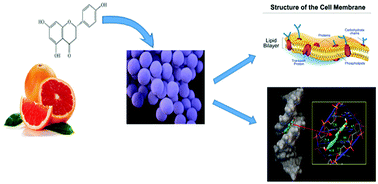当前位置:
X-MOL 学术
›
Integr. Biol.
›
论文详情
Our official English website, www.x-mol.net, welcomes your feedback! (Note: you will need to create a separate account there.)
Membrane and genomic DNA dual-targeting of citrus flavonoid naringenin against Staphylococcus aureus
Integrative Biology ( IF 2.5 ) Pub Date : 2017-08-22 00:00:00 , DOI: 10.1039/c7ib00095b Lang-Hong Wang 1, 2, 3, 4 , Man-Sheng Wang 1, 2, 3, 4, 5 , Xin-An Zeng 1, 2, 3, 4 , Xi-Ming Xu 4, 6, 7, 8, 9 , Charles S. Brennan 10, 11, 12, 13, 14
Integrative Biology ( IF 2.5 ) Pub Date : 2017-08-22 00:00:00 , DOI: 10.1039/c7ib00095b Lang-Hong Wang 1, 2, 3, 4 , Man-Sheng Wang 1, 2, 3, 4, 5 , Xin-An Zeng 1, 2, 3, 4 , Xi-Ming Xu 4, 6, 7, 8, 9 , Charles S. Brennan 10, 11, 12, 13, 14
Affiliation

|
The antimicrobial mechanism of naringenin, one of the citrus antibacterial flavonoids against food-borne Staphylococcus aureus ATCC 6538, was investigated in this study. Analysis of gas chromatography-mass spectrometry (GC-MS) and fluorescence showed that relatively low concentrations of naringenin caused perturbations in the membrane fatty acid composition and the conformation of membrane proteins through changing the microenvironment of phenylalanine, tyrosine, and tryptophan residues. Exposure of naringenin at higher levels significantly increased membrane permeability and changed the morphology of S. aureus cells. The genomic DNA-binding of naringenin was also quantitatively monitored using UV-vis spectra in combination with multivariate curve resolution-alternating least squares (MCR-ALS) analysis, and the concentration and pure spectra profiles for the three reaction species (DNA, naringenin, and DNA–naringenin) were obtained. Moreover, the thermal behavior of DNA and docking studies revealed that naringenin preferentially bound to the A–T base pair regions of genomic DNA via groove binding, and atomic force microscopy and circular dichroism showed that naringenin induced mild secondary structure and obvious morphological variations of this biomacromolecule. These results suggested that naringenin exerting its antibacterial effects might be connected with disruption of the cytoplasmic membrane and DNA targeting effects in Staphylococcus aureus.
中文翻译:

柑桔类黄酮柚皮苷对金黄色葡萄球菌的膜和基因组DNA双重靶向
本研究研究了柚皮素,一种柑橘类抗菌类黄酮类化合物,对食源性金黄色葡萄球菌ATCC 6538的抗菌作用。气相色谱-质谱(GC-MS)和荧光分析表明,较低的柚皮素浓度会通过改变苯丙氨酸,酪氨酸和色氨酸残基的微环境,引起膜脂肪酸组成和膜蛋白构象的扰动。较高浓度的柚皮素暴露可显着增加膜通透性并改变金黄色葡萄球菌的形态细胞。还使用UV-vis光谱结合多变量曲线分辨率-交替最小二乘(MCR-ALS)分析,三种反应物(DNA,柚皮苷,和DNA-柚皮苷)。此外,DNA的热行为和对接研究表明,柚皮苷优先通过以下方式与基因组DNA的A–T碱基对区域结合:沟槽结合,原子力显微镜和圆二色性表明,柚皮苷诱导了这种生物大分子的轻度二级结构和明显的形态变化。这些结果表明,柚皮苷发挥其抗菌作用可能与金黄色葡萄球菌的细胞质膜破坏和DNA靶向作用有关。
更新日期:2017-09-04
中文翻译:

柑桔类黄酮柚皮苷对金黄色葡萄球菌的膜和基因组DNA双重靶向
本研究研究了柚皮素,一种柑橘类抗菌类黄酮类化合物,对食源性金黄色葡萄球菌ATCC 6538的抗菌作用。气相色谱-质谱(GC-MS)和荧光分析表明,较低的柚皮素浓度会通过改变苯丙氨酸,酪氨酸和色氨酸残基的微环境,引起膜脂肪酸组成和膜蛋白构象的扰动。较高浓度的柚皮素暴露可显着增加膜通透性并改变金黄色葡萄球菌的形态细胞。还使用UV-vis光谱结合多变量曲线分辨率-交替最小二乘(MCR-ALS)分析,三种反应物(DNA,柚皮苷,和DNA-柚皮苷)。此外,DNA的热行为和对接研究表明,柚皮苷优先通过以下方式与基因组DNA的A–T碱基对区域结合:沟槽结合,原子力显微镜和圆二色性表明,柚皮苷诱导了这种生物大分子的轻度二级结构和明显的形态变化。这些结果表明,柚皮苷发挥其抗菌作用可能与金黄色葡萄球菌的细胞质膜破坏和DNA靶向作用有关。



























 京公网安备 11010802027423号
京公网安备 11010802027423号